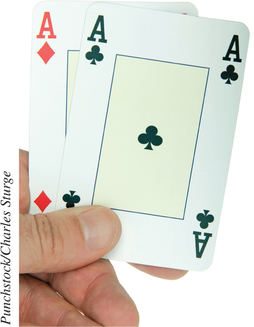EXAMPLE 25 Sampling without replacement

Suppose we alter the experiment in Example 24 as follows: We draw a card at random from a shuffled deck, hold onto the card (do not replace it) while the deck is reshuffled, and then select another card at random. What is the probability that both cards we select will be aces?
Solution
Define events A and B as in Example 24. Again we use the Multiplication Rule to find P(A and B). The difference in this experiment comes when finding P(B|A), the probability of observing an ace on the second draw given an ace on the first draw. Once we select the first ace, we do not replace it in the deck. Therefore, when the deck is reshuffled, it has only 51 cards left, only 3 of which are aces. The classical method then gives the probability of observing an ace on the second draw:
P(B given A)=number of aces in the decknumber of cards in the deck=351
Thus, the probability that both cards we select will be aces is
P(A and B)=P(A)·P(B given A)=452·351=122652≈0.0045
This probability is somewhat less than the probability that both cards will be aces when sampling with replacement. Note that here we found that P(B given A) was not equal to P(B). Thus, by the alternative method for determining independence, A and B are not independent events; they are dependent events.
NOW YOU CAN DO
Exercises 71–74.